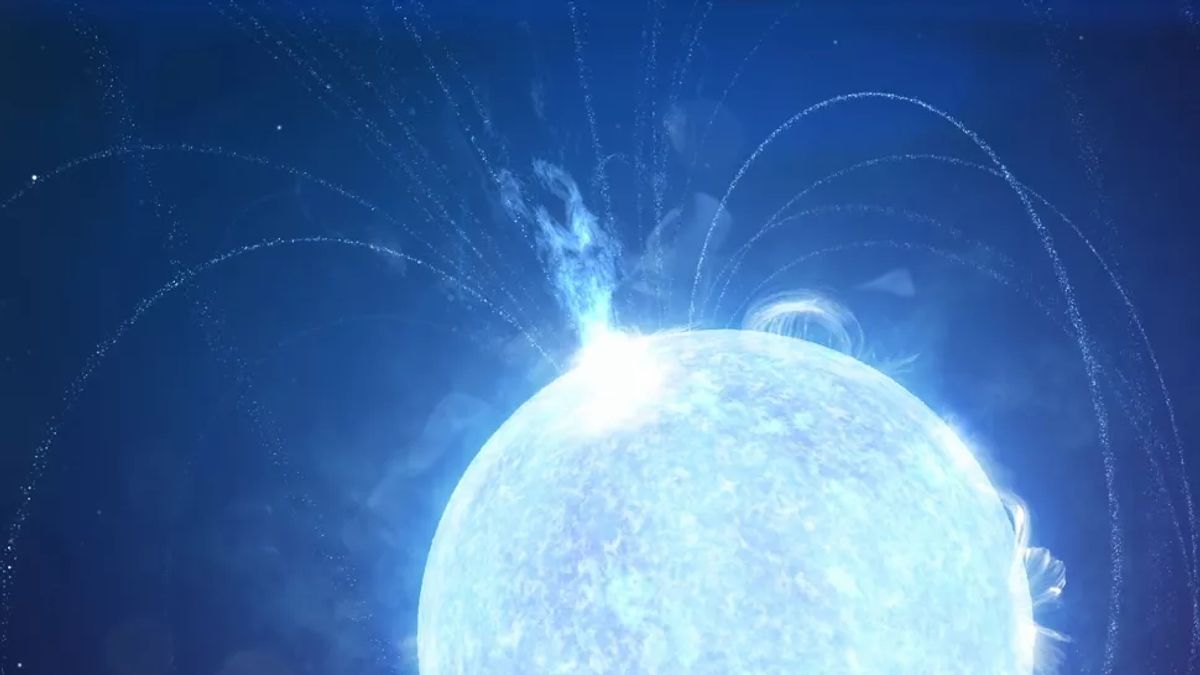JAKARTA - Scientists recently reported, a dense magnetic star erupted violently. This star spews out as much energy as a billion suns and it only happens in a fraction of a second.
This type of star, known as a magnetar, is a neutron star with a very strong magnetic field, and magnetars often light up spectacularly and without warning. But although magnetars can be thousands of times brighter than our sun, their eruptions are so brief and unpredictable that it is challenging for astrophysicists to find and study them.
However, researchers recently managed to capture one of these flares and quantify the oscillations in the brightness of the magnetar as it erupted. Scientists discovered that a distant magnetar releases as much energy as our sun produces in 100,000 years, and it does so in just 1/10 of a second, according to a statement translated from Spanish.
A neutron star is formed when a massive star collapses at the end of its life. When a star dies in a supernova, the protons and electrons in its core are crushed into a compressed solar mass that combines intense gravity with high-speed rotation and powerful magnetic forces, according to NASA.
As a result, a neutron star, measuring roughly 1.3 to 2.5 solar masses — one solar mass is the mass of our sun, or about 330,000 times that of Earth — is crammed into a sphere only 20 kilometers in diameter.
According to a livescience.com report, the matter in a neutron star is so dense that an amount the size of rock sugar would weigh more than 1 billion tons (900 million metric tons). The neutron star's gravitational pull is also so strong that a passing marshmallow would hit the star's surface with the force of 1,000 hydrogen bombs, according to NASA.
Magnetars are neutron stars with magnetic fields that are 1,000 times stronger than other neutron stars, and they are stronger than any other magnetic object in the universe. Our sun would appear pale in comparison to these bright, dense stars. Even when they didn't erupt once. This is explained by study lead author Alberto J. Castro-Tirado, a research professor at the Andalucía Institute of Astrophysics at the Spanish Research Council, in a statement quoted by livescience.com.
"Even in an inactive state, a magnetar can be 100,000 times more luminous than our sun," Castro-Tirado said. "But in the case of the flash we've studied - GRB2001415 - the energy released is equivalent to that of our sun in 100,000 years."
Giant Flare
The magnetar that produced the brief eruption is located in the Sculptor Galaxy, a spiral galaxy about 13 million light-years from Earth, and is a "true cosmic monster," study co-author Victor Reglero, director of the UV Image Processing Laboratory, said in a statement.
The giant flare was detected on April 15, 2020 by the Atmosphere–Space Interactions Monitor (ASIM) instrument on the International Space Station, researchers reported December 22 in the journal Nature.
The artificial intelligence (AI) in the ASIM channel detects the flare, allowing the researchers to analyze the short, loud energy wave; the flare only lasts 0.16 seconds and then the signal disappears so quickly that it is almost indistinguishable from the background noise in the data.
The study's authors spent more than a year analyzing the two-second ASIM data collection, dividing the event into four phases based on the magnetar's energy output, and then measuring the variation in the star's magnetic field caused by the pulse of energy at its peak.
"It's as if the magnetar decided to broadcast its existence "from its cosmic solitude" by screaming into the void with the power of "a billion suns," Reglero said.
Only about 30 magnetars have been identified out of about 3,000 known neutron stars, and this is the farthest magnetar flare detected to date.
Scientists suspect that eruptions like this might be caused by so-called stellar quakes disrupting the magnetar's elastic outer layer, and this rare observation could help researchers uncover the stresses that produce the energy burps of the magnetar, according to the study.
The English, Chinese, Japanese, Arabic, and French versions are automatically generated by the AI. So there may still be inaccuracies in translating, please always see Indonesian as our main language. (system supported by DigitalSiber.id)









